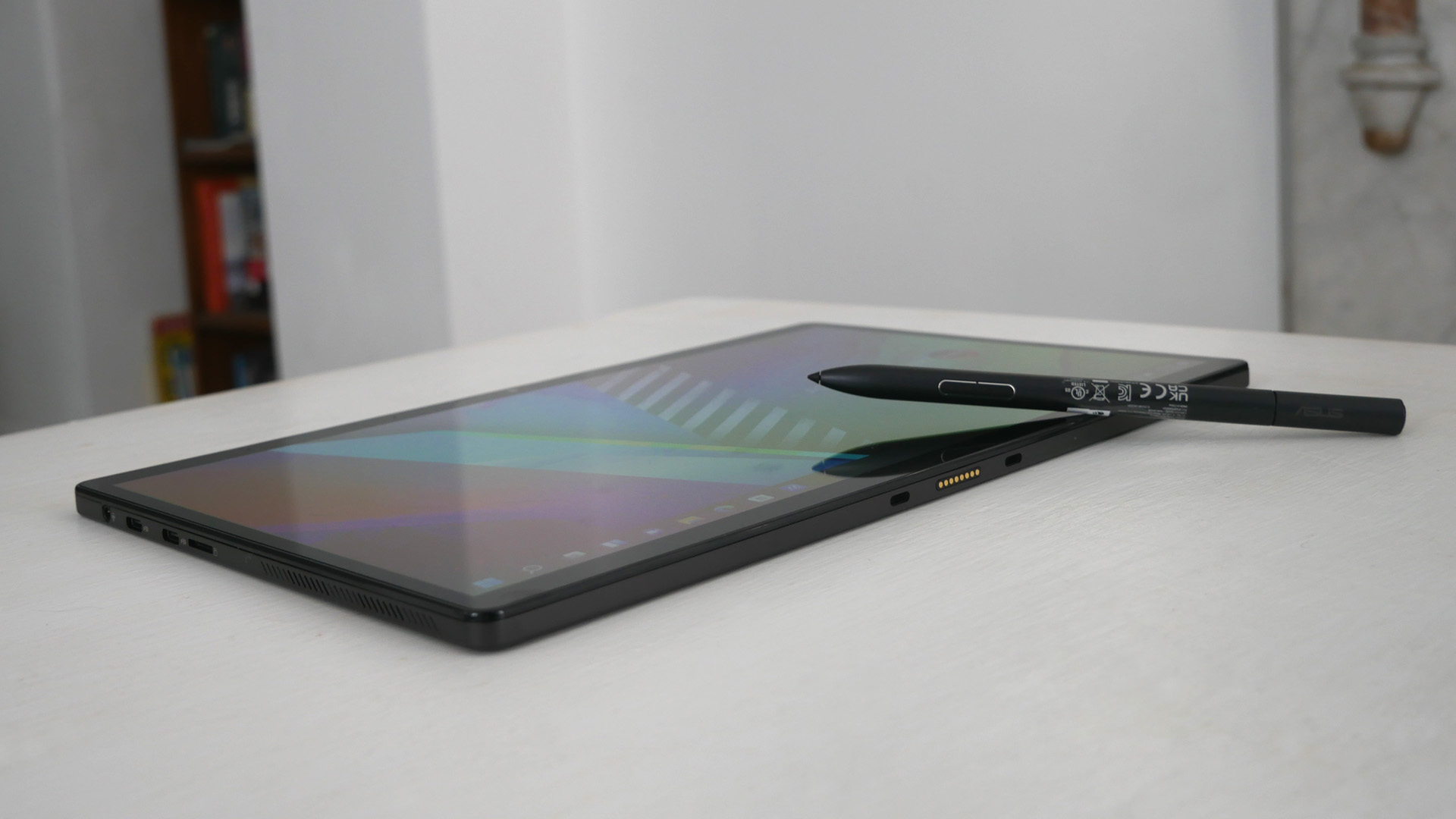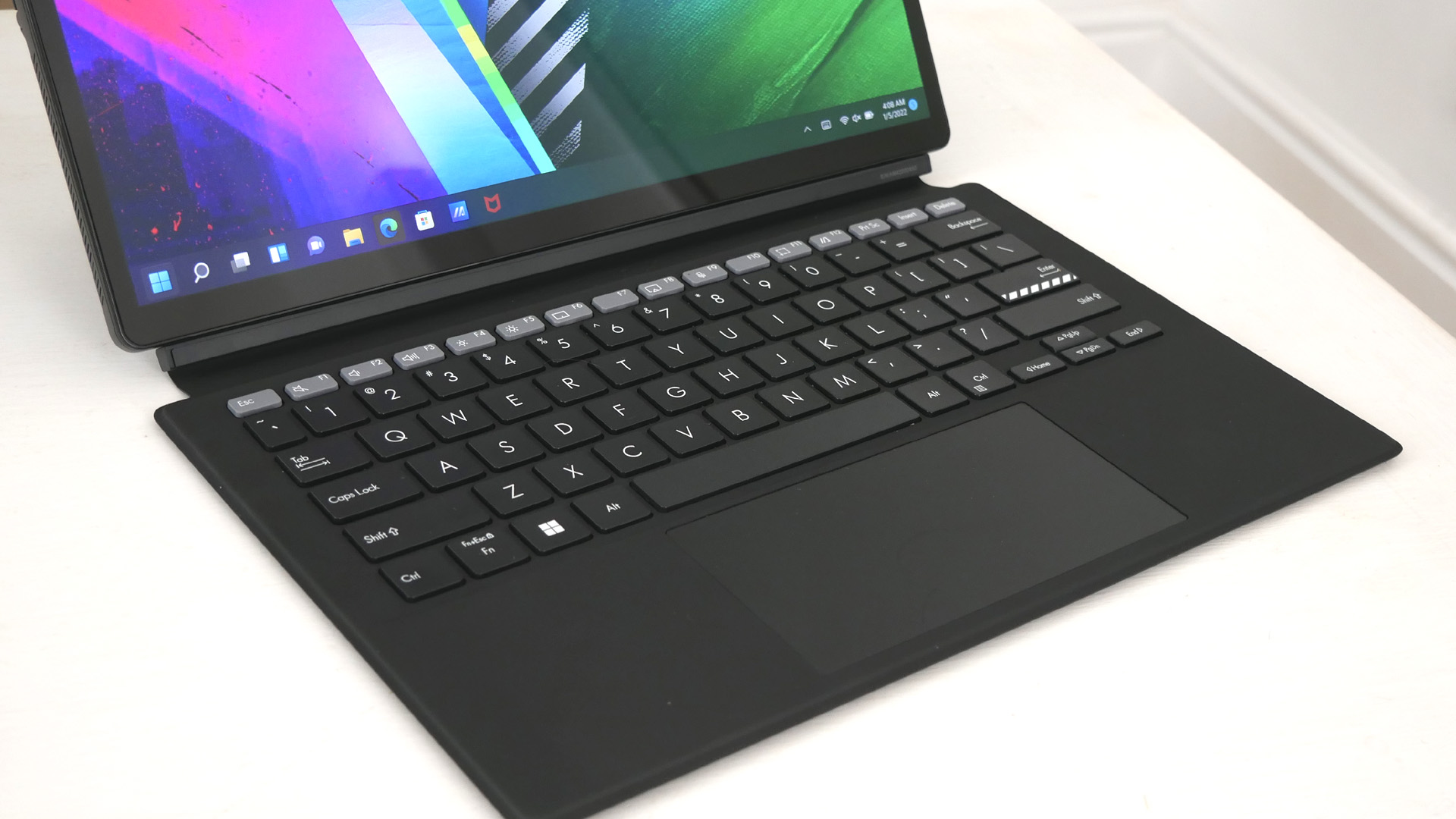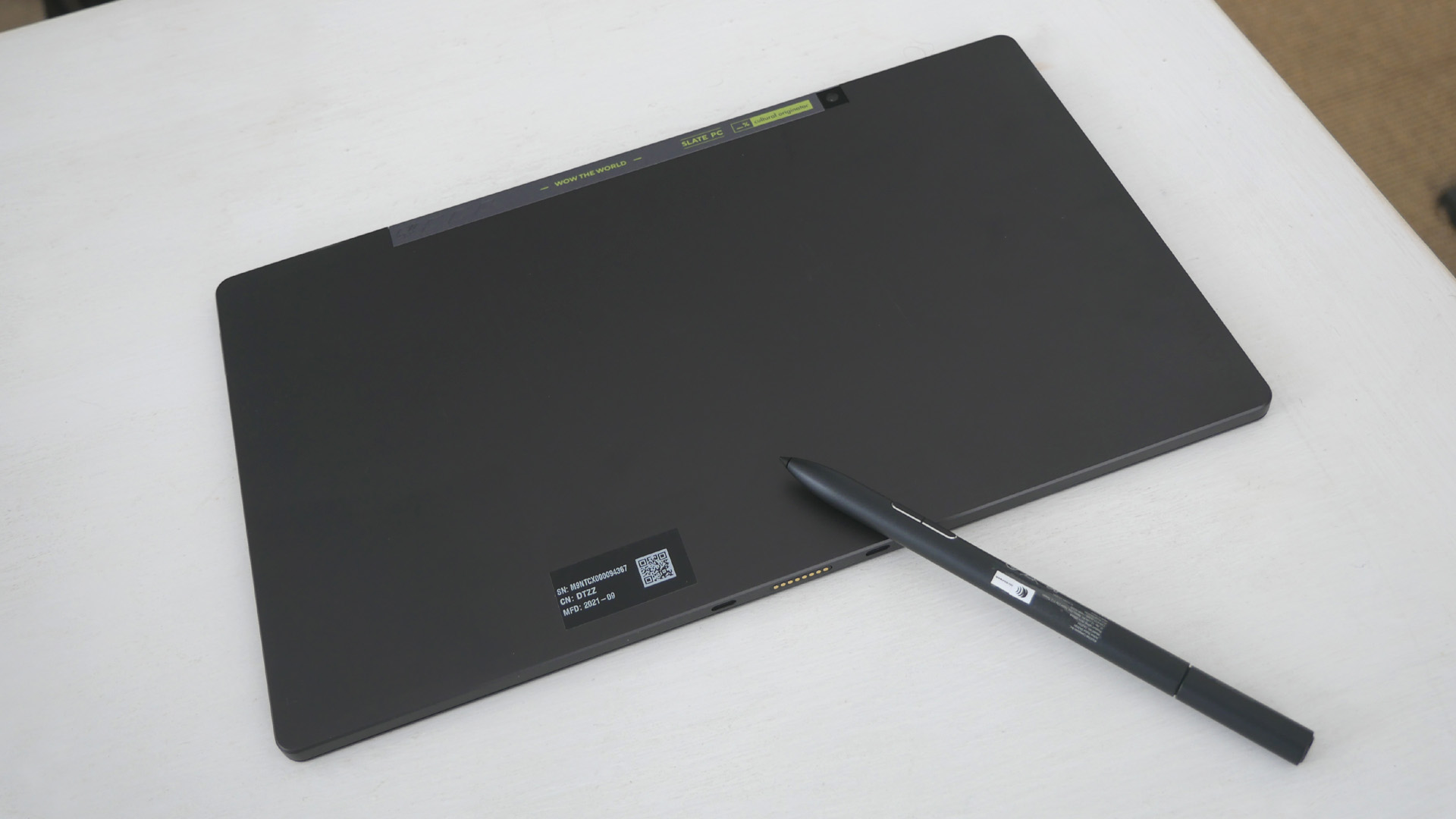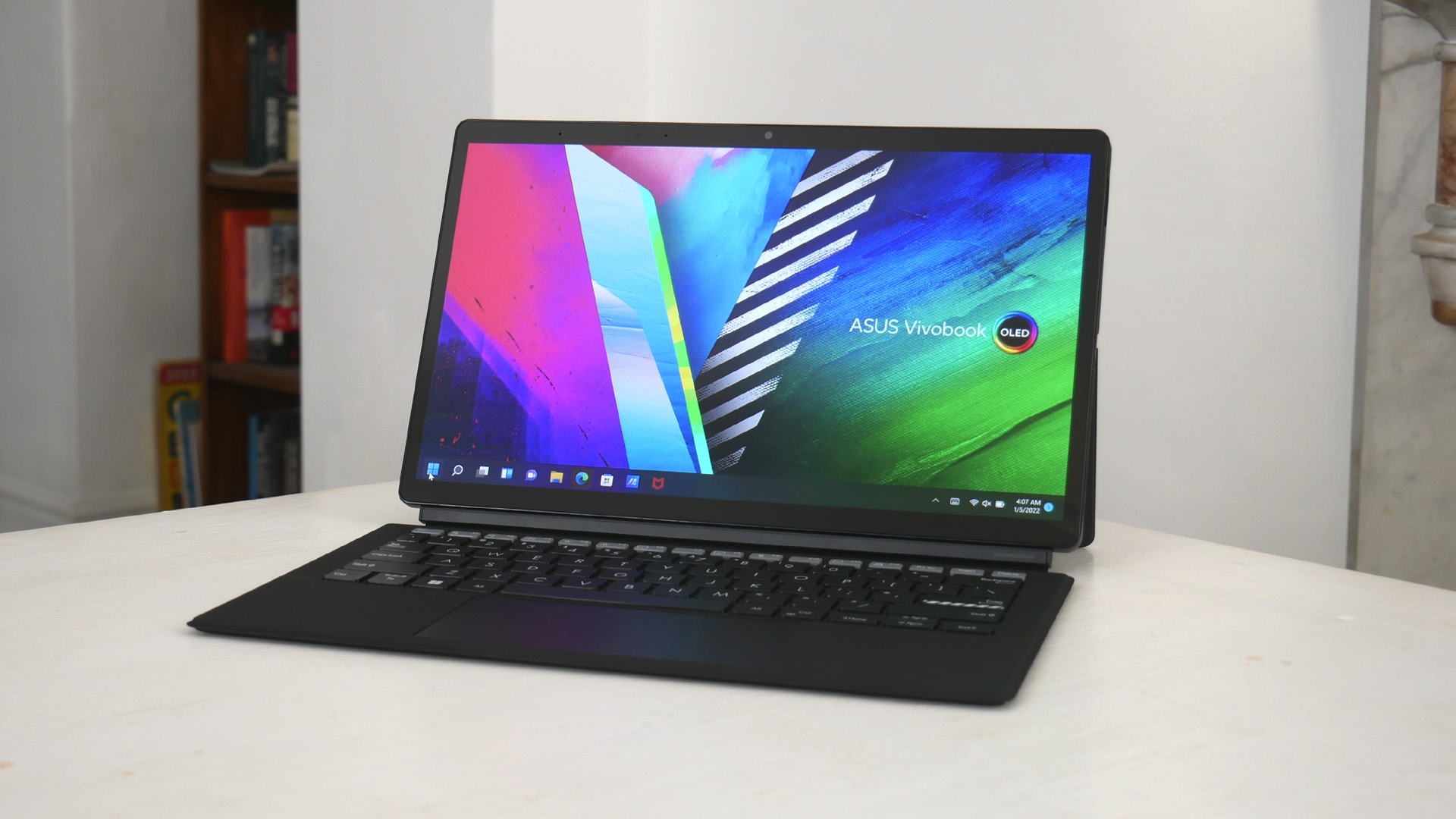TechRadar Verdict
Asus’s new affordable convertible laptop is big on OLED screen thrills, but short on performance frills.
Pros
- +
OLED panel great for movies
- +
Strong feature set and build
- +
Decent battery life
Cons
- -
OLED not so great for productivity
- -
Very weak CPU performance
Why you can trust TechRadar
Two-minute review
A PC and OLED TV in one. Those are Asus’s words, not ours. And quite a claim for the Asus Vivobook 13 Slate OLED to live up to. Heck, it’s quite a claim for any device to deliver on, let alone a 13-inch laptop that works as a Windows tablet.
Whatever, the Vivobook 13 Slate OLED certainly has plenty going for it, the most obvious of which is a 13.3-inch OLED panel with a punchy 550 nits of peak brightness. The competition in the PC-based slate market generally still goes with LCD screen tech. It’s also very slick and slim, with fairly narrow bezels, a skinny chassis and nice build quality. And all for under $600 / £600.
You also get plenty of input options beyond the touchscreen. Both the Asus Pen 2.0 and a detachable keyboard are part of the comprehensive standard package. Other highlights include quad-speaker Dolby Atmos sound, Wi-Fi 6, dual cameras, two high-speed USB-C ports, a MicroSD card slot, quick charging and more.
Oh, and did we mention the 1080p OLED panel offers fully 100% coverage of the demanding DCI-P3 cinema color space, something even professional desktop monitors struggle to achieve, plus 0.2ms response times? Oh, yeah. There’s plenty to like.
There are also a few details, however, that don’t entirely bear close scrutiny. Take the CPU. It’s a quad-core Intel chip capable of over 3GHz, which sounds nice until you realise the Intel Pentium Silver N6000 is based on Intel’s Atom lineage of CPUs. You could think of it as having four efficiency cores a la Intel’s new Alder Lake processors. Except, the cores in the Pentium Silver N6000 are older than the efficiency cores in Alder Lake and not nearly as powerful.
Consequently, performance is pretty glacial. Installing large apps takes a long time, despite the 256GB SSD and 8GB of DDR4 memory. Loading proper apps takes plenty of time, too. And forget about anything graphically intensive. The Pentium chip’s integrated graphics are feeble.
The showpiece OLED panel isn’t quite the stunner you might hope for. As handheld devices go (which includes this one at least part of the time), the Vivobook’s 1080p resolution makes for mediocre pixel density on a 13-inch screen. Making matters worse, it’s unclear if the Vivobook’s panel has conventional RGB subpixels. OLED panels commonly don’t.
Sign up for breaking news, reviews, opinion, top tech deals, and more.
Anyway, the Vivobook’s screen isn’t terribly sharp and doesn’t render fonts all that crisply. In mitigation, video does look great thanks to the inherent advantages of OLED tech, including excellent viewing angles, more or less infinite contrast and super-speedy response.
The otherwise unimpressive Pentium chip also does a good job of decoding high bitrate video streams, including 4K YouTube. It also offers decent battery life of around nine hours for video playback, albeit comparably priced ARM-powered tablets typically last quite a bit longer.
All told, from a content consumption perspective this machine has quite a bit going for it. The fact that it’s way cheaper than premium Windows tablets like the Microsoft Surface Pro 8 likewise adds to the appeal. But the Vivobook’s weak performance and the limitations of its showcase OLED display make for a mixed proposition overall.
Price and availability
Here is the Asus Vivobook 13 Slate OLED configuration sent to TechRadar for review:
CPU: 1.1GHz Intel Pentium Silver N6000 (quad-core, 4MB cache, burst up to 3.3GHz)
Graphics: Intel UHD integrated
RAM: 8GB DDR4 RAM
Screen: 13.3-inch 1080p OLED
Storage: 256GB M.2 NVMe SSD
Optical drive: N/A
Ports: 2x USB-C, MicroSD
Connectivity: Wi-Fi 6(802.11ax)+Bluetooth 5.2 (Dual band) 2*2
Camera: 5MP front, 13MP rear
Weight: 1.72 pounds (0.78 kg)
Size: 12.20 x 7.48 x 0.31 inches (30.99 x 19.00 x 0.79 cm; W x D x H)
At $599 (around £600, AU$840), the Asus Vivobook 13 Slate OLED looks like good value. It’s a full-function PC in tablet-convertible format, complete with detachable keyboard and input pen. It also gets OLED display technology, which makes for a very appealing overall package. The catch is a weak Intel Pentium processor. At this price point, you can’t have everything.
For less money, you can have Microsoft’s smaller 10-inch Surface Go with a full suite of accessories and a similar CPU. For the same money you can have the Go with a more powerful Intel Core M3 chip, but you’ll have to pay extra for a keyboard and input pen. The entry-level Microsoft Surface 7 Pro can be had for similar money but comes with very few frills. All of which means a case can be made for the Vivobook in value terms as a media consumption device. But for anything resembling real computing, it’s less compelling.

Design
Slick design and great build quality are certainly part of the Asus Vivobook 13 Slate OLED’s core appeal. The tablet portion is genuinely compact with slim bezels around the 13.3-inch OLED panel and very nicely put together. It’s just 8mm thick, weighs in at just over three quarters of a kilo and encloses a 50WHr battery.

The chassis also contains a quad-speaker system with Dolby Atmos support. In terms of overall volume, it’s reasonably punchy. But the sound quality is very thin and tinny.
Still, the clip-on keyboard is reasonably tactile for the device type with 1.4mm of key travel and a nice, big trackpad, while the Asus Pen 2.0 boasts a 266Hz sample rate.

The magnetic kickstand is also easy to use and works well. Like all such solutions, while the combination of the kickstand and clip-on keyboard is great for desks and tables it doesn’t work nearly as well on your lap.
Along with the pen and power supply, it also makes for quite a bundle of kit to stuff in your bag, although the USB-C charging means you could share a single power supply across multiple devices.

Anyway, a laptop with a touchscreen is certainly a less complicated computing device. You’d have to really want the tablet functionality. Ports-wise, you get a pair of high-speed USB-C sockets, plus a MicroSD card reader. That’s probably plenty for this type of device.
Being able to connect at least one peripheral while charging is the least you’d want. Elsewhere, you get a 5MP forward-facing camera, plus another 13MP camera on the rear.

Performance
Here's how the Asus Vivobook 13 Slate OLED performed in our suite of benchmark tests:
3DMark: Night Raid: 3,903; Fire Strike: 1,100; Time Spy: 386
Cinebench R20 Multi-core: 628 points
GeekBench 5: 686 (single-core); 1,913 (multi-core)
PCMark 10 (Home Test): 2,632 points
PCMark 10 Battery Life: 7 hours and 29 minutes
Battery Life (TechRadar movie test): 9 hours
If the Asus Vivobook 13 Slate OLED has a weakness, it’s the Intel Pentium Silver N6000 CPU. On paper, a quad-core Intel chip capable of over 3GHz sounds like plenty for this type of device. In practice, it’s based on Intel’s low-power class of processors, previously known as Atom.
At best, you could argue the Pentium’s cores are efficiency orientated like those in the new Alder Lake desktop processor. In reality, they’re not even that good. It makes for a sluggish experience. Installing and opening apps takes an age. It took around 20 minutes for Metro Exodus to load, for instance, only for it to promptly crash about a quarter of the way through the benchmark run. OK, a demanding game like that is irrelevant on this device type, but it’s indicative of the Vivobook’s significant limitations.
Even the Windows 11 UI can feel laggy at times, though one thing the Vivobook is good at is video playback, including demanding 4K streams. For that type of content consumption, this is a compelling device. That’s especially true thanks to the stupendous contrast and colours from the OLED display. Asus’s claims that the Vivobook can double as a TV is a stretch, but watching movies and TV is certainly a pleasure.
That said, the 1080p panel is less convincing on the Windows desktop. The OLED panel lacks a little sharpness and doesn’t render fonts terribly crisply. Partly that’s down to pixel density - 1080p on a 13.3-inch panel isn’t all that by tablet standards. But it may also be due to non-RGB subpixel structure in the OLED panel, which if present is never a good thing for font rendering.
Battery life
The Asus Vivobook 13 Slate OLED clocks in around nine hours for video playback, which is a decent result for an x86-powered computing device running Windows as opposed to, say, an Android tablet with an ARM chip.
Problem is, the overall computing experience is hobbled by the low-power Intel CPU. So, you’re not really getting a full PC experience.
Arguably, you’d be better off either with a more powerful system with an Intel Core or AMD Ryzen CPU, or with an ARM-based tablet that was even more portable and even longer lasting. The Asus Vivobook 13 Slate OLED ultimately doesn’t quite strike a satisfying balance between longevity and performance.

Buy it if...
You love OLED tech
Asus claims the Vivobook is the first convertible Windows laptop to sport an OLED panel. It certainly looks great for video playback with awesome contrast and uber punchy colours.
A tablet convertible is your bag
The Asus Vivobook 13 Slate OLED is a full- feature convertible complete with a keyboard and input pen included in the price, not to mention that luscious 13.3-inch OLED panel.
You want bang for your buck
The Asus Vivobook 13 Slate OLED is competitively priced given its overall feature set. If you mainly want to watch video, this could be a great device, albeit with limited additional utility.
Don’t buy it if…
You want usable application performance
The Intel Pentium chip is, frankly, feeble and delivers a disappointing overall experience in Windows. Installing and running apps takes an age and even the UI can feel sluggish.
You’re serious about pen computing
Bundling the Asus Pen 2.0 is a nice touch. But the weak performance of the Intel CPU renders it a little redundant. Running Photoshop, for instance, is not a nice experience.
You think OLED is infallible
In this application, OLED may not be the best option. Video looks good, but overall crispness and font rendering are not strong points of the 13.3-inch 1080p OLED panel.
- These are the best laptops
Technology and cars. Increasingly the twain shall meet. Which is handy, because Jeremy (Twitter) is addicted to both. Long-time tech journalist, former editor of iCar magazine and incumbent car guru for T3 magazine, Jeremy reckons in-car technology is about to go thermonuclear. No, not exploding cars. That would be silly. And dangerous. But rather an explosive period of unprecedented innovation. Enjoy the ride.
